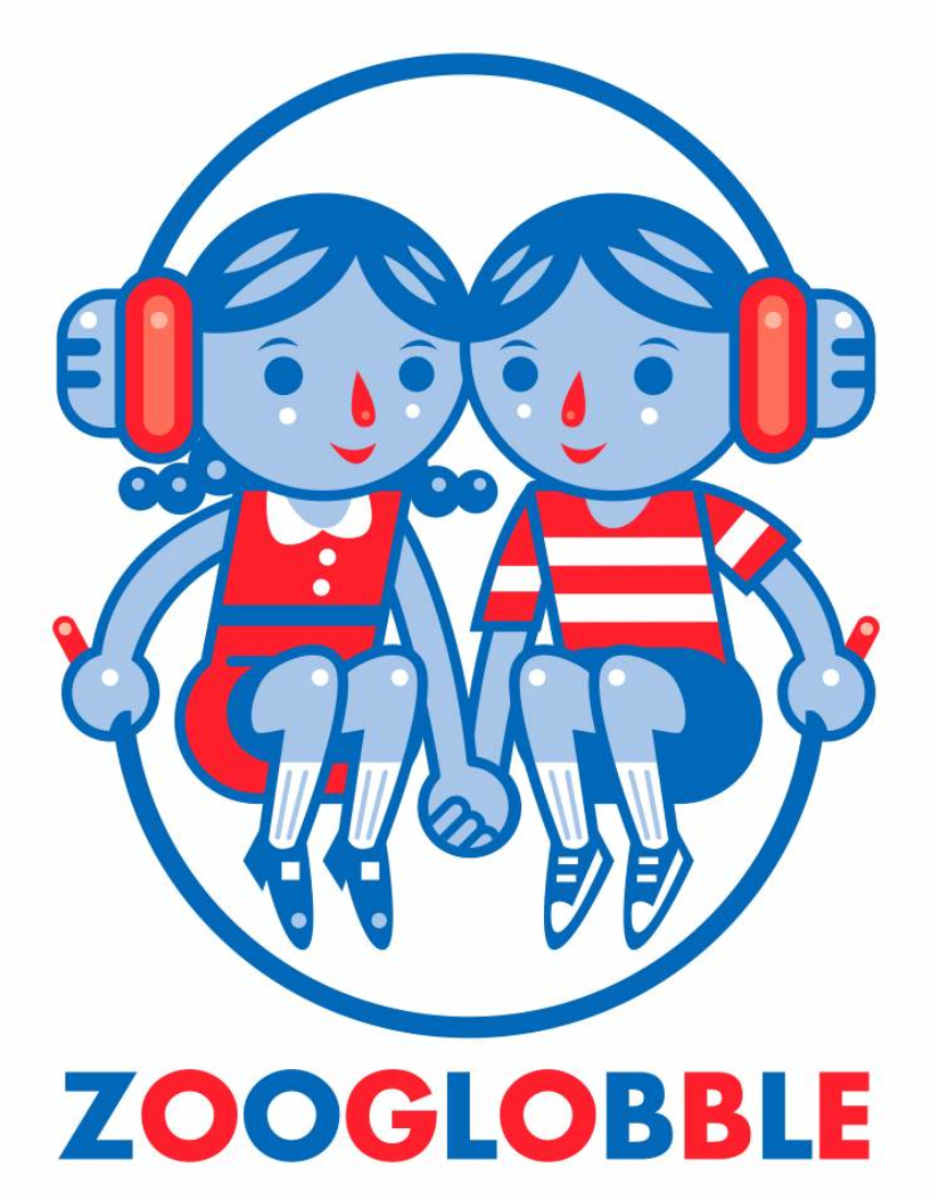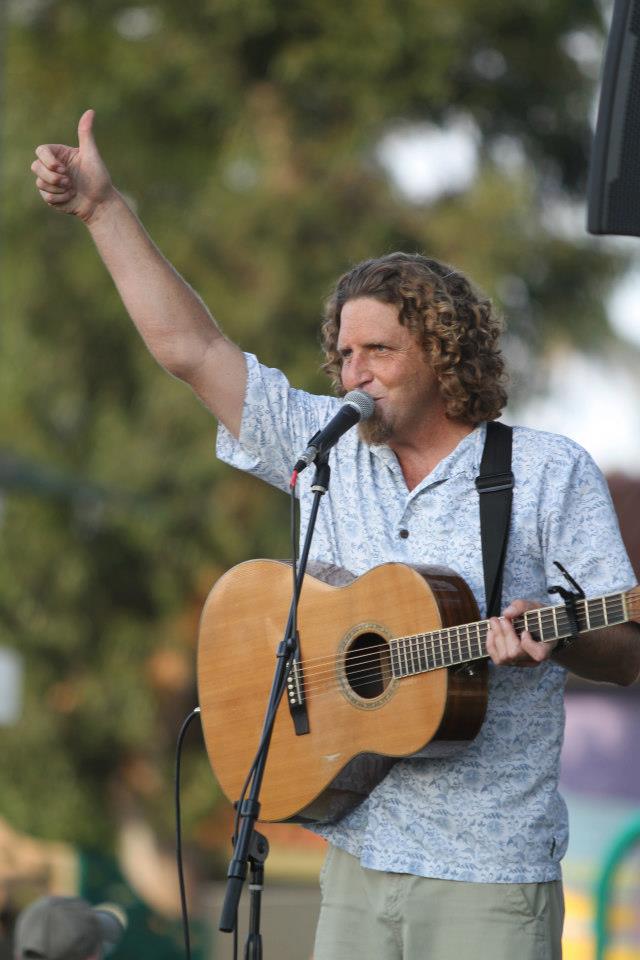Zooglobble: What was the genesis for Ear Snacks -- what was the point at which you said, “Hey, I’ve got an idea!”? How did it come about?
Polly Hall (P): That is such a big question. We both wanted to do something that wan’t an album that was a longer-form project, and we brainstormed a lot of different concepts for what it could be. We work with children’s television, so thinking about doing something bigger is totally within reach of what we might want to do. But to know exactly what we wanted to do and could do was really hard to figure out.
Andrew Barkan (A): Yeah, we knew we wanted to do something beyond the songs that captured the way we’d learned to interact with our audiences through playing with them for five years out here in Los Angeles. When we did our first album before we left New England we hadn’t played very many shows at all. And then we came out to L.A. and tried to play those songs and found... these kids like them, but when you’re in a room with 50 kids, you have to know how to hold their attention spans, how to engage them with the subject matter and since we generally don’t put on a big rock stage-y, concert-y type show with gimmicks and things, we want the actual content of what we are saying and how we are listening and asking our fans to participate in the concert to be the meat of the concert.
P: Until recently we hadn’t really done large stage concerts. Now we do more of them. But in doing hundreds of performances...
A: Maybe 50 a year for awhile...
P: ... either with their parents or in schools...
A: A lot of carpet...
P: ... we learned how to reach them on the right developmental level. One of the best pieces of feedback we got from parents and educators -- aside from saying, we like the music -- was saying we really got the kids. So we knew we wanted to do something where we could demonstrate really getting kids.
A: Yeah, understanding their developmental level and allowing them to participate in the concert. So we thought a podcast where parents interviewed their kids would be a great way for us to engage with our fans and for us to be able to interact with things they say. Kids feel real special when someone’s asking them a question, let alone asking them a question with a microphone.
Is that why perhaps you didn’t do a video series, that the podcast allowed for interactivity?
P: Yeah, the interactivity was key for us. We had somebody suggest to us a few years ago, because we’ve done a few off-the-cuff couch YouTube videos that kids really like, that we need[ed] to do that every week. But we saw people doing that on YouTube and we thought, when we talk with kids, they don’t have to see us to really love the experience and since we’re comfortable with music and comfortable with recording technology, we also had to think practically -- what’s something that we could do ourselves?
A: We know how to create a lot more magic with audio than we know how to with video.
P: We thought about different things we could do -- we thought about doing fiction, a narrative thing, but it felt like too much to do. We didn’t know if we could write convincing material, do music, and act or hire and direct a cast. But what we knew we could do was work with kids.
A: Right -- ask them questions, see what they think about stuff.
P: And we know how it goes when we’re in a room with fifty of ‘em, and we figured we could take a little bit of that full-of-life experience and get to people we aren’t able to see directly on a weekly or monthly basis.
A: But we’ve gotten to interact with fans in New Zealand or Brazil or Missouri through this where we’ve never been to those places. So that’s pretty cool.
How did you map out the episodes? Did you say, we want to do an episode on, say, “strings”? But how did you come up with the ideas for each episode, which are based on a theme on a particular topic?
A: We had a whole list -- a Google doc, or a spreadsheet --
P: There’s probably a hundred topics we didn’t use.
A: We picked the first four that we were going to block out, and delayed them because we wanted to find experts. “Fruits” and “Hats” were definitely in the first four.
P: I can’t remember how we got to hats.
A: It was Izzy’s first word.
P: Yeah! Well, it wasn’t his first word -- he said “dada” and stuff like that -- but it was the first one he picked. He found that word. And then everywhere we looked, all we could see was hats... I think those first few came to us fairly easily. What was it?... Fruit, hats, balls... Those were more obvious. I think at the beginning, we were more like, let’s pick something, like, universally kid-loved...
A: ... without being lollipops, dinosaurs...
P: ... right, but let’s pick things kids want to talk about, because we didn’t know who we were going to get to talk to. The first episode is kids of people we knew, and now we have kids who write in from all over who want to be on. Those first three, we thought about our preschool audience, we thought about things that were simple and we let them take us somewhere else. But then it got little bit more complex. We probably thought them in batches, so...
A: The next set was disguises, critters, boxes.
P: We came up with those three together. And then the next ones we had a brainstorming session and came up with the rest of them together. We kind of sweated them out, too. We couldn’t decide, and we were really specific about what made it. Like the very last episode of season [was] “Moves” and to get into the conversation of what is an Ear Snacks episode and what isn’t in a way that doesn’t make any sense that is kind of intuitive but also has a rigid sense of qualifications, “moves” was chosen over “steps,” tracks,” uh, I can’t remember...
A: “Tickets”
P: Yeah, tickets. But we did try to think once we did the first six, what balances out these other things. Where can we go to complement what we’ve already done
A: Because they kind of fall into different categories of things -- they’re all tangible objects, except for “Pairs,” maybe, or “Disguises,” which is how you’d use an object, or “Shadows,” which is not tangible. But they’re things kids know about, and we try to think of things we can approach from many different angles that we can get kids thinking about creatively -- the meanings of certain words. For something as simple as “Balls,” like what is the biggest ball in the universe? What is the smallest ball? What balls can you see in your room, and everyone picks the regular sports ball first, and then you start realizing, it’s this shape -- why do we have this shape? What are the forces that make this shape a thing in our world?
P: So on the one hand it has to be a topic that has a lot of depth but on the other hand if we thought about anything for as long as we thought about these episodes, we could probably find something to talk about.
Did you choose topics knowing you had a really good song and wanted to turn it into an episode, or did you choose topics, and then write the songs, or was it a little bit of both?
A: Both, absolutely both. “Grapes,” for example, we had written -- we had the hook for awhile -- and we had decided to make “fruit” the first episode because we knew we had this great song we thought would make a great kickoff for the podcast.
P: We almost didn’t put it in, though...
Nooooooo! Nooooo!!!!
P: ... because at some point... was it going to be a single? Was it going to be in the podcast? But at some point we realized this was some sort of fruit anthem, it can’t not be in there. Some of it is chicken-and-egg, some of it is one or the other.
A: But the reverse is... sometimes over the course of an episode, we have this thing that the kids have access to and it relates to something larger and we don’t know what the larger relationship idea is... like “Rain.”
P: Yeah, “Rain” was written pretty much after the whole episode was finished. We were sitting around talking about how all the different parts of the episode connected together and what that meant and we wrote that song sitting on the floor of the studio talking about that stuff. That song would never have been written if we hadn’t of...
A: ... If we hadn’t talked to your friend who was a hydrologist who came up with the idea of, we can predict climate, we can see it over millions of years -- we can see glaciers and we know they’re going to recede and disappear because of the way climate is changing -- yet we can’t say, because weathermen are always wrong and so is the weather app, what the weather’s going to be like this afternoon.
P: And that’s an experience children feel all the time. They don’t know what’s coming up next and they don’t know how to handle that and when we started to think about that, all that stuff just started to come out, whereas some of the other songs, like “Critters,” for example... We had a cover of a Bill Staines song, “Critters,” on our previous record which inspired the episode about animals, but didn’t actually appear in the episode because we didn’t want to go to the trouble of seeking out copyright, the intellectual property rights.
A: All of these podcasts, it’s original, it’s ours.
P: But in that way, the idea of “critters,” of talking about them, of all the different parts of “critters” in the country and world, we probably wouldn’t have done that if we hadn’t have chosen that song.















